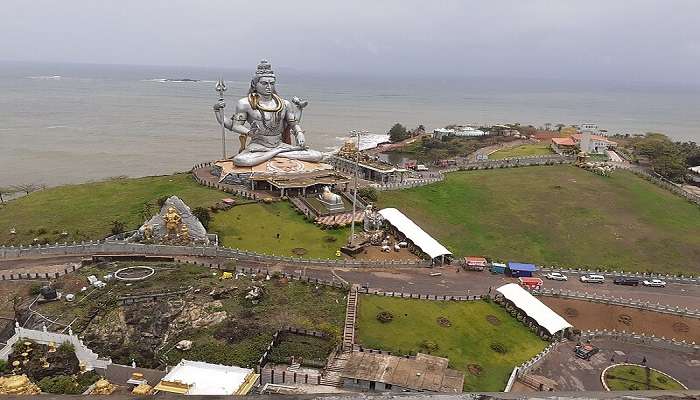Unravelling The Mysteries Of Angkor’s Dawn With Bakong In Cambodia On Your 2026 Trip

Journey back to the cradle of Khmer civilisation at Bakong, Cambodia. This remarkable 9th-century temple, nestled near Siem Reap, stands as one of the earliest temple constructions of all Angkor-era temple mountains. Inspired by Mount Meru, Bakong is built in the form of a stepped pyramid, a pioneering design and an engineering marvel that paved the way for iconic temples like Angkor Wat. Intricate carvings and towering gateways hint at the craftsmanship that went into this architectural marvel. Bakong offers more than just historical significance; it’s a tranquil sanctuary, invites you to soak in the beauty of a bygone era.
Bakong Temple Siem Reap
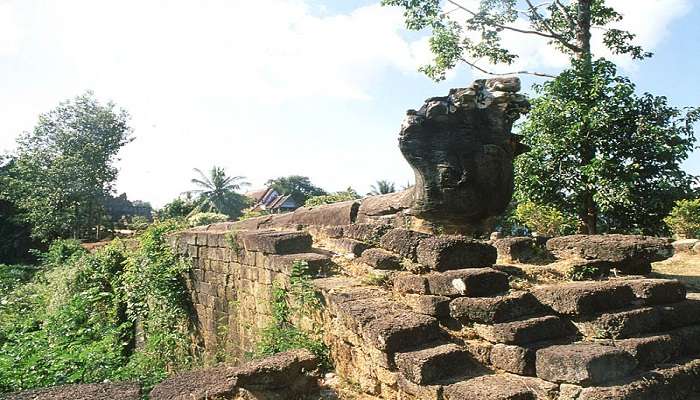
One of the largest temples in Siem Reap, the sheer stature of Bakong temple is spread over 15 hectares of land in the ancient city of Hariharalaya, which today is in Bakong District in Siem Reap Province. This 9th-century temple was named after King Indravarman I, after the ceremonial event he had held at the nearby Preah Ko temple.
During the Angkorian period, most of the mountain temples were usually named after a presiding deity and the king who had built it. Therefore, the Bakong temple was originally named Indreshvara (after King Indravarman and the Hindu God Shiva). The Bakong temple in Siem Reap is regarded as the first inaugural temple or the model for other mountain temples. Regarding its architecture, the Bakong started to incorporate elaborative elevation. There are, in total, five steps of elevation, which contribute to the height and charm of the temple. Also, smaller towers are built on the fourth elevation and bigger ones at ground level. Most of the bigger towers were either built of clay or laterite stones combined with sandstone.
Must Read: Prasat Ta Keo
Bakong Architecture

The Bakong architectural site spans 900m x 700m, featuring three concentric enclosures separated by moats. The outer enclosure doesn’t have any walls or gopurams, with its boundary marked by the outer moat. Accessible via NH6, the current road leads to the edge of the second enclosure. The inner moat surrounds a 400m x 300m area with laterite walls, four gopurams, and a causeway adorned with seven-headed Nagas. Twenty-two brick satellite temples lie between the moats. The innermost enclosure is enclosed by a laterite wall and features a central temple pyramid, eight brick towers, and a few smaller structures called stupas.
Eight brick towers on platforms encircling the main temple are arranged symmetrically. They are dedicated to the eight aspects of Shiva called Murtis (“faces”), which are the Sun, Moon, Earth, Water, Air, Fire, Ether and Atman. Their walls bear traces of masterpieces of stucco, the best preserved are on the western towers. The main structure, of course, is the central temple-mountain, built of sandstone blocks. The structure is 67 m long, with a width of 65 m wide and 14 m high. Unusual rectangular pavilion gates with pitched roofs and gable ends and with semicircular moonstone thresholds give access to axial stairways on each side. Lions guard the four flights of steps. The upper tiers are narrower and less high than the lower ones. Statues of elephants face outwards on the corners of the three lower tiers. The higher the tier, the smaller the size.
Bakong History
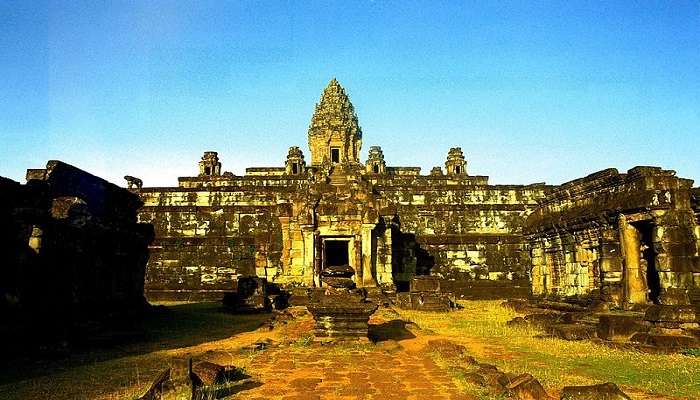
In 802 AD, Angkor’s first king, Jayavarman II, established Cambodia’s authority. The construction of Bakong, Angkor’s first sandstone temple mountain was done at his then capital Hariharalaya. King Indravarman I dedicated Bakong to Lord Shiva in 881 AD, symbolising divine kingship. Though Bakong served briefly as Angkor’s state temple, later additions suggest continuous use into the 12th or 13th century. Indravarman’s successor, Yasovarman I, shifted the capital from Bakong to Angkor, founding the city of Yaśodharapura and building the temple mountain Bakheng. This transition marked a crucial moment in Angkor’s history, signalling its rise as a prominent cultural and religious centre.
Suggested Read: Cambodia Monuments
Bakong Nearby Attractions
Bakong Temple Siem Reap is surrounded by several notable attractions. Visitors can explore the historic Preah Ko and Lolei temples, each showcasing unique aspects of early Khmer architecture. These attractions collectively offer a rich historical and cultural experience, making the area a captivating destination for travellers.
1. Lolei
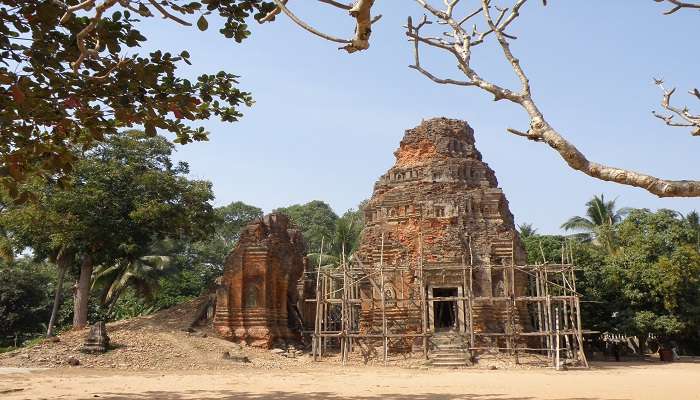
Located east of Siem Reap, Lolei, or Loley, is a fascinating and charming 9th-century ancient brick temple group located north of Preah Ko and Bakong temple. The site features a tiered laterite platform measuring around 100 m x 100m in width and length and rising to around 3 m in height. This temple received restoration in 2022 to preserve the remains. The temples feature the architectural prowess and stunning craftsmanship of the Angkor era. The entrance to the temple is from the East.
Distance from Bakong: 3 km approx.
Timings: 6.00 am – 6.00 pm
Suggested Read: Cambodia Resorts
2. Preah Ko
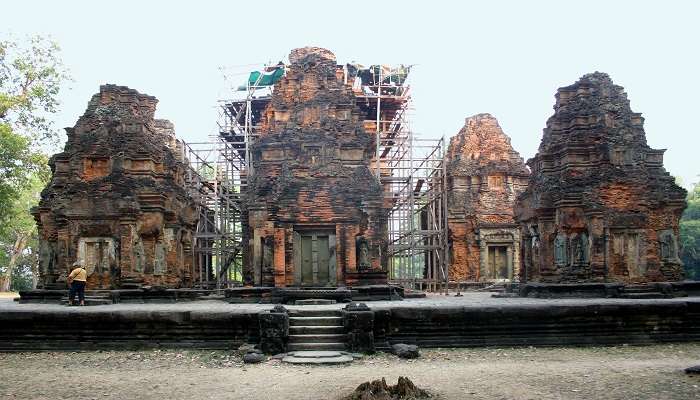
Built under King Indravarman I, Preah Ko is a beautiful ancient temple famed for its art. The temple was founded in 879 AD, according to its inscription, and was built as a Hindu temple dedicated to his ancestors. The highlights of Preah Ko are certainly the remarkable state of preservation of the 6 towers – the niches with Dwarapala (guards at the entrance) and intricate carvings of the deities around the walls, the stunning art of the lintels and decoration, and also the chance to see remnants of the final stucco rendering which only a few temples are left with.
Distance from Bakong: 1.6 km approx.
Timings: 7.30 am – 5.30 pm
Further Read: Places To Visit In Cambodia
Bakong, one of Cambodia’s most revered landmarks, enchants visitors with its timeless charm and architectural splendour. Visiting Bakong Temple Siem Reap is essential for appreciating the country’s rich history, stunning architecture, and cultural significance. A trip to Cambodia guarantees an awe-inspiring experience and memories that will be cherished for a lifetime.
For our editorial codes of conduct and copyright disclaimer, please click here.
Cover Image credit : By Christophe95 for Wikimedia Commons.
Frequently Asked Questions About Bakong
What is the best time to visit Bakong?
Mornings are less crowded, hence the best time to visit.
What are the Bakong Temple ticket details?
The ticket covers Angkor Wat and all the temples under Angkor Archaeological Park. One-day tickets cost around USD 37, and three-day tickets cost around USD 62.
What are the Bakong temple timings?
Bakong temple timings start from 7.30 am – 5.00 pm daily.
Are there any food and drink stalls available near Bakong Temple?
Yes. Stalls providing food and cool drinks are available near the East and Western side of the site.
What are the things to take when visiting Bakong?
Comfortable clothing with shoes, insect repellent, and water are recommended.
People Also Read:
Jui Tui Shrine Devipattinam Navgraha Temple Girija Devi Temple

With a passion for exploring and travelling to the roads long forgotten, experience the world through enthralling stories and adventures. Join me as I share my experiences at some of the world’s most popular tourist destinations and quench that pestering curiosity with something exciting!




